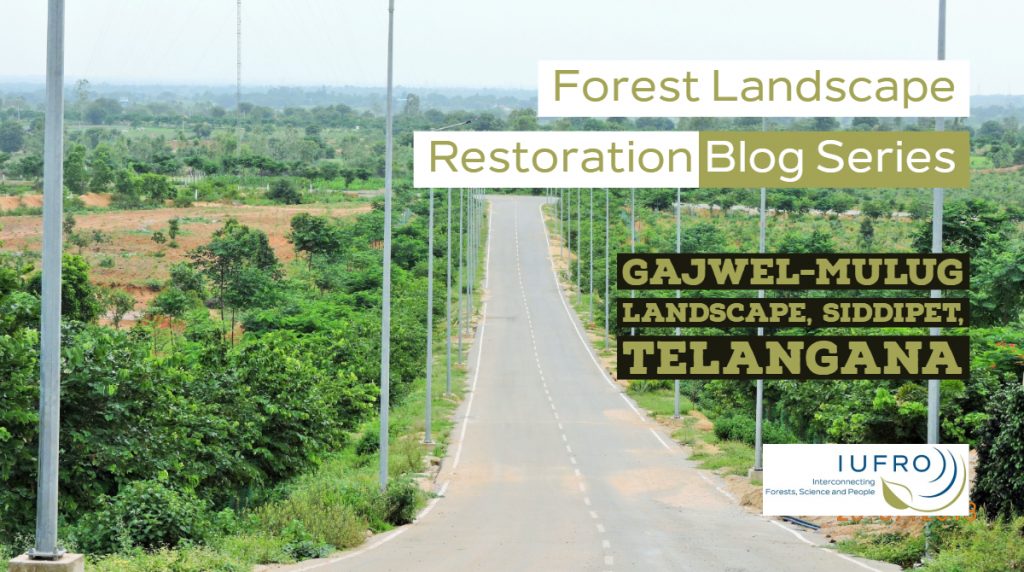Land of Taj Mahal and the second-most populous country in the world. India is the fourth country of the blog series on the Forest Landscape Restoration Implementation: Progress on the Ground.

Telangana state of India was formed barely five years back by the reorganization of the erstwhile state of Andhra Pradesh and immediately on its formation the first Chief Minister of the state decided that the state would devote itself wholeheartedly both to very fast paced economic development and its ecological regeneration. For achieving the latter, the state launched a comprehensive greening program christened “Telangana Ku Haritha Haram” in 2015 which has received unwavering support by the Chief Minister of Telangana thus ensuring fullest commitment from all wings of the state government and continuous flow of funds even under most trying conditions.
Most degradation in forests in the state has been caused by severe biotic pressures due to excessive removals of wood for energy and other uses, grazing, weed infestation, soil erosion, reduced ability of the soils to hold moisture and frequent wildfires leading to poor regenerative capacity, high mortality, and reduced growth rates across most species in the forests. Under this program Assisted Natural Regeneration (ANR) activities involving digging of deep trenches along the forest boundaries to prevent biotic interferences, soil and moisture conservation, protection against fire, weed removal, cultural operation along with enrichment planting have been taken up in areas having forest canopy density 0.1 to 0.4 while artificial regeneration involving block planting has usually been confined to those parts of forests within this landscape that have canopy density of less than 0.1. Outside the forests, large scale tree planting with peoples’ participation have been taken up under agroforestry, homestead, avenue planting and on tank foreshores. Native timber and non-timber tree species of high economic value preferred by local communities have either been planted or otherwise encouraged.
All available public lands under the control of government departments, corporations and institutions, including educational and training institutions of all descriptions, have also been planted up with trees of appropriate species by the concerned departments and organizations themselves with technical support from the forest department. Private industries, business houses, and educational and other institutions have also been persuaded to bring all unused lands in their control under tree cover with the technical support of the forest department.
The status of regeneration is monitored closely at several levels in the forest department and casualty replacement is done at the earliest. All regeneration areas are protected by watchmen from local communities against possible damage by cattle and other causes. Uninterrupted flow of planting stock, manpower, and funds, to every point of activity is ensured at different levels of the forest department through a well-designed online monitoring mechanism.
The results have been very encouraging. Telangana has already achieved restoration of about 0.3 million ha of degraded forest area and expects to achieve about 1.0 million ha in a phased manner over the next five to six years that should, hopefully, enable India to meet its targets under the Paris Climate Agreement, the Bonn Challenge, and the New York Declaration on Forests in full.
A snapshot analysis undertaken under the aegis of IUFRO between April to August 2019 suggests this remarkable success is largely due to the high-level political commitment towards the greening up of the state and setting up robust institutional arrangements at all levels of governance. Mass participation by people has been enabled by creating public awareness at the grassroots as also through specially designed orientation programs for public representatives in the state legislative assembly, district and municipal bodies, and village panchayats.
Overall, the project had a strong political collaboration, which contributed to the success of the project as well as the acceptance and active participation of the people in the implementation of the landscape restoration.
Download the poster: https://www.iufro.org/fileadmin/material/science/spps/spdc/FLR_Snapshot/iwc19-flr-snapshots-poster-india-telangana.pdf
To find out more about India, watch their interview on the side-event Forest Landscape Restoration Implementation: Progress on the Ground during the XXV IUFRO World Congress 2019.
Check out the other countries to know more about forest landscape restoration.
Coming up next…
Guatemala: Forest Restoration: enabling environment and mobilizing stakeholder’s support in Guatemala.

Leave a Reply